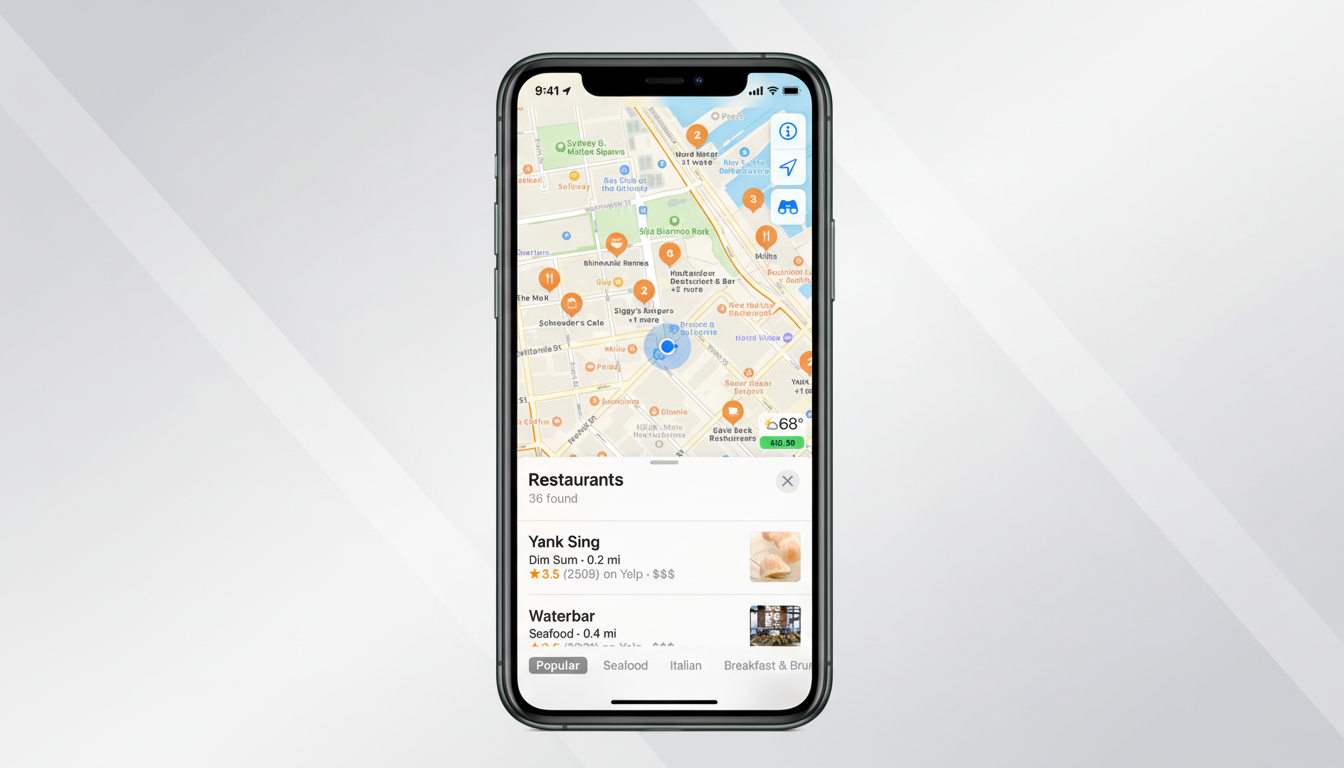Apple Maps could start displaying advertising as early as next year, Bloomberg’s Mark Gurman reported. If it goes ahead with the plan, Apple would follow rivals that are similarly monetizing their maps: generating revenue from sponsored listings at a time when its iPhone business has stopped growing and investors are hunting for new pots of gold. The strategy drags the world’s most valuable company into a debate over privacy and technology in other kinds of businesses — tech companies adding location-based advertising to their arsenal without killing user goodwill or distorting the product’s clean design or privacy-first marketing pitch.
What Ads in Apple Maps May Look Like for Users
At first, expect to see simple formats: sponsored pins on the map, promoted results at the top of local searches, and enhanced place cards that display paid profiles in searches for things like “coffee,” “pizza,” or “pharmacy.” Apple is likely to fall back on on-device machine learning for ranking ads by relevance — with context such as search intent, proximity, and time of day, etc., to be used in a bid to avoid confusing ads with organic results, given the clear labeling that will be applied to placements.
- What Ads in Apple Maps May Look Like for Users
- Why Apple Is Doing This Now for Its Services Growth
- How It Compares With Google Maps and Existing Ads
- Privacy and Targeting Considerations Apple Must Balance
- What Businesses Should Expect From Apple Maps Ads
- Timeline and Early Signs to Watch for Apple Maps Ads

In a believable early scenario, it might look more like what users experience in Google Maps and Waze now: a “Sponsored” tag that is small on top of a list, low ad density per screen, and bidding value for real users rather than high spend.
Apple’s Business Connect program, which allows merchants to control information such as hours and images, is a logical foundation for getting advertisers on board and confirming business data.
Why Apple Is Doing This Now for Its Services Growth
Apple’s Services division is increasingly a growth engine, and advertising already appears in App Store search, News, and Stocks. Analysts at eMarketer as well as investment banks have put Apple’s ad business in the mid-single-digit billions per year, providing plenty of room to grow. Mapping local ads addresses a high-intent moment, one where people are deciding where to go, so this is among the most-monetizable surfaces on iOS.
The timing also ties into Apple’s wider privacy positioning. “With App Tracking Transparency making cross‑app tracking more difficult, Apple can now lean on first‑party context — what you search for within Maps, and where you are located — to deliver relevant ads without requiring the construction of profiles that traverse the web,” Mr. Bandt-Young wrote in a recent note to clients. That path threads the needle between monetization and Apple’s public promises on data minimization.
How It Compares With Google Maps and Existing Ads
Google Maps has spent years developing local ad formats, from promoted pins to sponsored place cards, and serves more than a billion monthly users globally. That scale has left Google with a vast trove of reviews and ad demand, particularly from mom-and-pop businesses. Apple, meanwhile, has focused on data quality in mapping, lane-level guidance, and features like Look Around and offline maps but hasn’t gotten bogged down with commercial clutter.
The risk for Apple is perception among users: even tasteful ad units can feel obtrusive in a navigation app. The opportunity is differentiation. If Apple can keep ad load light, lean into utility, and bet on on-device relevance rather than heavy-handed retargeting, it could introduce a “privacy forward” option to compete in app map ads that still make it significant money.

Privacy and Targeting Considerations Apple Must Balance
Anticipate Apple to be guided by three principles.
- Visible distinction so you don’t click on an ad thinking it’s a search result.
- The factors for targeting should be context-specific — query, location, and time — not cross-app behavior.
- Privacy-preserving measurement could involve aggregated reporting techniques to estimate taps, directions requests, and in-store visits without compromising individuals’ identities.
Apple could technically apply the same on-device ranking it does in iOS overall to minimize server-side data. Any such expansion would be subject to close regulatory scrutiny in places with tough privacy and competition rules, such as the EU under the Digital Markets Act, which is forcing Apple to keep controls and disclosures front of mind.
What Businesses Should Expect From Apple Maps Ads
For local retailers, map ads can be a high-ROI channel since intent is explicit. Restaurants, retailers, service providers, and gas stations are probably early adopters. Apple could perhaps price campaigns on a cost-per-tap or cost-per-directions request metric, just like local elsewhere, with budget managed through Business Connect and reporting that emphasizes incremental directions and calls.
Multi-location chains often appreciate brand-level budgets and shared assets, while independents will desire the most precise geographic targeting that can prevent budget wastage.
Should Apple give ratings and photos more weight in paid placements, merchants will have to invest in the quality of their listings to compete, rather than simply bidding higher.
Timeline and Early Signs to Watch for Apple Maps Ads
Gurman’s reporting suggests their introduction could come as soon as next year. Apple has a history of quietly testing new ad products before scaling them as it fine-tunes how much to disclose, how they’ll perform, and how users will react. Clues might come in the form of rollouts to Business Connect for “promotions,” ad disclosures in app release notes, and developers making reference to sponsored place APIs around Apple’s annual developer conference.
The trade-off is obvious, in other words: inject commercial relevance at the right moment when users are looking for it, without overwhelming them with ads. If Apple can pull off that balancing act, Maps could become one of its most lucrative new ad surfaces — and a new front in its yearslong war with Google to own local discovery on mobile.

